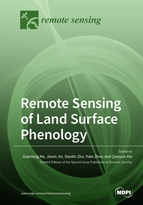Remote Sensing of Land Surface Phenology
A special issue of Remote Sensing (ISSN 2072-4292). This special issue belongs to the section "Biogeosciences Remote Sensing".
Deadline for manuscript submissions: closed (30 April 2022) | Viewed by 40309
Special Issue Editors
Interests: remote sensing of vegetation; phenology; biodiversity; global change
Interests: vegetation phenology; climate change; carbon–water coupling
Interests: remote sensing; spatial data analysis; data fusion; vegetation phenology
Special Issues, Collections and Topics in MDPI journals
Interests: remote sensing; land surface phenology and climate feedback; vegetation productivity; carbon cycle; ecology of global change
Interests: vegetation monitoring; ecological forecasting; vegetation parameter retrieval; vegetation phenology; climate variability
Special Issues, Collections and Topics in MDPI journals
Special Issue Information
Dear Colleagues,
Land surface phenology (LSP) involves the use of remote sensing to monitor seasonal dynamics in vegetated land surfaces and to retrieve phenological metrics (transition dates, rate of change, annual integrals, etc.). LSP, as an important field in environmental and climate remote sensing science, has undergone rapid development over the last few decades. Both regional and global LSP products have been routinely generated and played prominent roles in modeling crop yield, ecological surveillance, identifying invasive species, modeling the terrestrial biosphere, and assessing global change impacts on urban and natural ecosystems.
Recent advances in field and spaceborne sensor technologies as well as data fusion techniques have enabled novel LSP retrieval algorithms that refine LSP retrievals at even higher spatiotemporal resolutions, providing new insights into ecosystem dynamics. Meanwhile, rigorous assessment of the uncertainties in LSP retrievals are undergoing, and efforts in seeking ways to reduce these uncertainties are also forming an active research field. In addition, open source software and hardware are being developed and have greatly facilitated the use of LSP metrics by scientists beyond the remote sensing community. As such, we organized this Special Issue to cover the latest developments in sensor technologies, LSP retrieval algorithms and validation strategies, and the use of LSP products in a variety of fields. In doing so, we hope to not only summarize the ongoing diverse LSP developments but also boost discussions on future prospects in LSP research. We welcome contributions that fall within, but are not limited to, the following topics:
- Advances in LSP retrieval algorithms
- Assessing and reducing the uncertainties in LSP retrievals
- Retrieving LSP using optical, microwave, LiDAR, and SIF
- Ensuring long-term continuity of LSP across sensors and satellite missions
- Applying multisensor data fusion techniques for LSP
- Proposing improved satellite LSP validation strategies using ground observations
- Near-real-time monitoring and short-term forecasting of LSP
- Retrieving LSP from nanosat constellation and geostationary satellites
- Developing LSP products using cloud platforms such as GEE and PIE-Engine
- Developing phenocams (phenology cameras) for LSP applications
- Developing open source computer code, software, and hardware for LSP
- Prototyping and upgrading regional, national, and global LSP products
- Applying LSP in agriculture, ecology, LULC, and global change
- Tracking the long-term trends and IAV of LSP and its interaction with regional climate
- Exploring the interactions between LSP and climate/human activities factors
Thank you and we look forward to receiving your contributions!
Dr. Xuanlong Ma
Dr. Jiaxin Jin
Dr. Xiaolin Zhu
Dr. Yuke Zhou
Dr. Qiaoyun Xie
Guest Editors
Manuscript Submission Information
Manuscripts should be submitted online at www.mdpi.com by registering and logging in to this website. Once you are registered, click here to go to the submission form. Manuscripts can be submitted until the deadline. All submissions that pass pre-check are peer-reviewed. Accepted papers will be published continuously in the journal (as soon as accepted) and will be listed together on the special issue website. Research articles, review articles as well as short communications are invited. For planned papers, a title and short abstract (about 100 words) can be sent to the Editorial Office for announcement on this website.
Submitted manuscripts should not have been published previously, nor be under consideration for publication elsewhere (except conference proceedings papers). All manuscripts are thoroughly refereed through a single-blind peer-review process. A guide for authors and other relevant information for submission of manuscripts is available on the Instructions for Authors page. Remote Sensing is an international peer-reviewed open access semimonthly journal published by MDPI.
Please visit the Instructions for Authors page before submitting a manuscript. The Article Processing Charge (APC) for publication in this open access journal is 2700 CHF (Swiss Francs). Submitted papers should be well formatted and use good English. Authors may use MDPI's English editing service prior to publication or during author revisions.
Keywords
- Land surface phenology
- Vegetation dynamics
- Global change
- Land use/land cover
- Multisensor integration
- Geostationary satellite
- Micro/nanosatellite constellation
- Phenology validation
- Unmanned aerial vehicles (UAVs)
- Phenology cameras and citizen science
- Optical, microwave, chlorophyll fluorescence
- Big data and cloud computation
- Open source computer code, software, and hardware
- Ecological surveillance and forecasting
Related Special Issue
- Remote Sensing of Land Surface Phenology II in Remote Sensing (2 articles)










